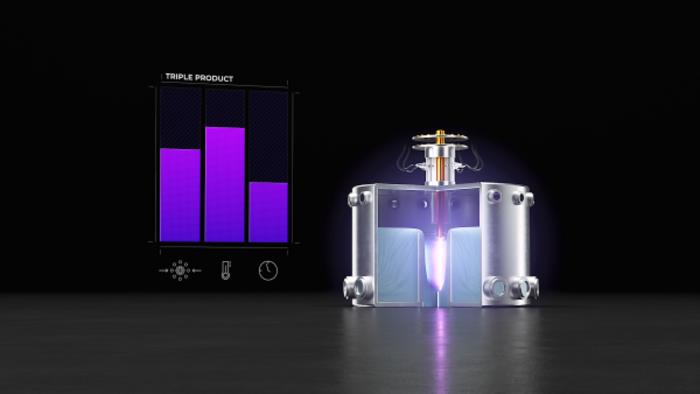In the race to develop fusion energy, each unique approach requires its own specialized techniques to determine net energy gain, an equation balancing energy in and out that’s known by the letter Q.

Credit: Zap Energy
In the race to develop fusion energy, each unique approach requires its own specialized techniques to determine net energy gain, an equation balancing energy in and out that’s known by the letter Q.
A new paper, published today in the journal Fusion Science and Technology, establishes the company’s method of measuring and calculating Q in Zap’s sheared-flow-stabilized Z-pinch fusion plasmas. The publication will be an important part of Zap demonstrating energy gain on the way to building a commercial fusion system.
“The way we generate fusion-grade plasmas in our devices is different from other fusion technologies so this paper helps lay the groundwork for quantifying our progress,” says Uri Shumlak, Zap Energy cofounder, Chief Science Officer and lead author on the paper.
A distinctive approach
Like other fusion devices, Zap Energy plans to fuse hydrogen nuclei within material called plasma that must be superheated to temperatures hotter than the sun. The plasma properties can be measured to determine Q, or net energy gain, partly by calculating their triple product: how hot and how dense a plasma is, and how long it lasts.
Triple product is useful when comparing different fusion concepts, such as looking at how sheared-flow-stabilized Z-pinch devices differ from more traditional fusion devices, such as the tokamak, or other fusion approaches, and can also be used as a simplified proxy for Q.
In Zap’s case, its distinctive Z-pinch plasmas are about 100,000 times more dense than those in tokamaks and last for many microseconds. A pulsed system is being designed to create plasmas repeatedly.
Zap’s plasmas flow in a line with material at different distances from the inner-most part of the line moving at different speeds from its outer edges. This creates what’s called sheared-flow stabilization, which maintains the plasma long enough for sustained fusion reactions to occur. Sheared-flow stabilization allows Zap to confine plasmas without external magnets, but also leads to the need for uniquely suited measurements and analysis.
Measuring Q
To calculate triple product, Zap measures the temperature of the plasma, its density, and the flow velocity to determine the duration of plasma confinement. The corresponding calculation of Q is the ratio of fusion power (output) to input power and compares closely to the method used to measure gain in other magnetic confinement approaches, such as the tokamak. Inertial confinement approaches, like last year’s demonstration of Q>1 by Lawrence Livermore National Laboratory’s National Ignition Facility, produce short-lived plasmas and define Q as the ratio of fusion energy to input energy.
The main difference between power and energy is that power is the energy per unit of time. Since Zap’s plasmas are confined for timeframes that sit between traditional magnetic and inertial fusion approaches, choosing to calculate Q based on power is an important distinction.
“Publishing these technical details is very important. You can’t just drop a thermometer into a fusion plasma to see what’s happening, so instead we use a combination of direct and indirect observations that help give a picture of the conditions,” says Ben Levitt, Zap Energy Vice President of R&D. “This paper gives us a chance to make sure that other physicists agree our methodology conforms well with what’s been established over the years in the fusion community and lays out the way we plan on reporting our results in the near future.”
Z-pinch nuances
The paper includes a number of details that are specific to Zap’s fusion approach. One of the most important is accounting for the input power needed to drive the stabilizing plasma flow.
The paper also notes that for high performance pinches, it’s likely an energetic product of the fusion reactions called alpha particles will be trapped and boost fusion gain by offsetting some of the required input power.
Zap plans to correlate observations of plasma conditions with measurements of neutrons being emitted. Because neutrons are a primary product of fusion reactions, scientists would expect them to increase when fusion conditions are right and decrease when they’re not.
Zap achieved the first plasmas on its fourth-generation device, FuZE-Q, last May. R&D campaigns are now underway using FuZE-Q. The Zap team will analyze results from both FuZE-Q and its predecessor FuZE as they push toward demonstrating the first sheared-flow-stabilized Z-pinch plasmas capable of Q>1.
About Zap Energy
Zap Energy is building a low-cost, compact and scalable fusion energy platform that confines and compresses plasma without the need for expensive and complex magnetic coils. Zap’s sheared-flow-stabilized Z-pinch technology provides compelling fusion economics and requires orders of magnitude less capital than conventional approaches. Zap Energy has over one hundred team members in two facilities near Seattle and is backed by leading financial and strategic investors. Visit Zap online at zapenergy.com.
Journal
Fusion Science & Technology
DOI
10.1080/15361055.2023.2198049
Method of Research
Experimental study
Subject of Research
Not applicable
Article Title
Fusion Gain and Triple Product for the Sheared-Flow-Stabilized Z Pinch
Article Publication Date
5-Jun-2023




